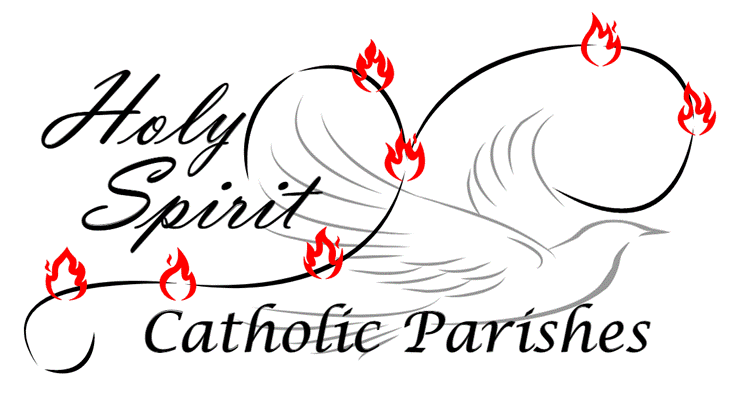History
History of St. Jane Frances, Randolph, Nebraska
In the formative years of the City of Randolph, the Catholics of the community were served by priests from the surrounding parishes on an irregular basis. Father Charles Mugan made his first visit to Randolph on March 9, 1889, for the purpose of administering baptism to Margaret Lynn, infant daughter of Mr. and Mrs. John Lynn. The first Holy Sacrifice of the Mass was celebrated in Randolph on April 9, 1889, by Father Mugan. There were only five or six persons in attendance. At this time, Father Mugan was stationed in Wayne. A certain Father Wallace also came to Randolph to celebrate Mass periodically. There is no record regarding his first name or address.
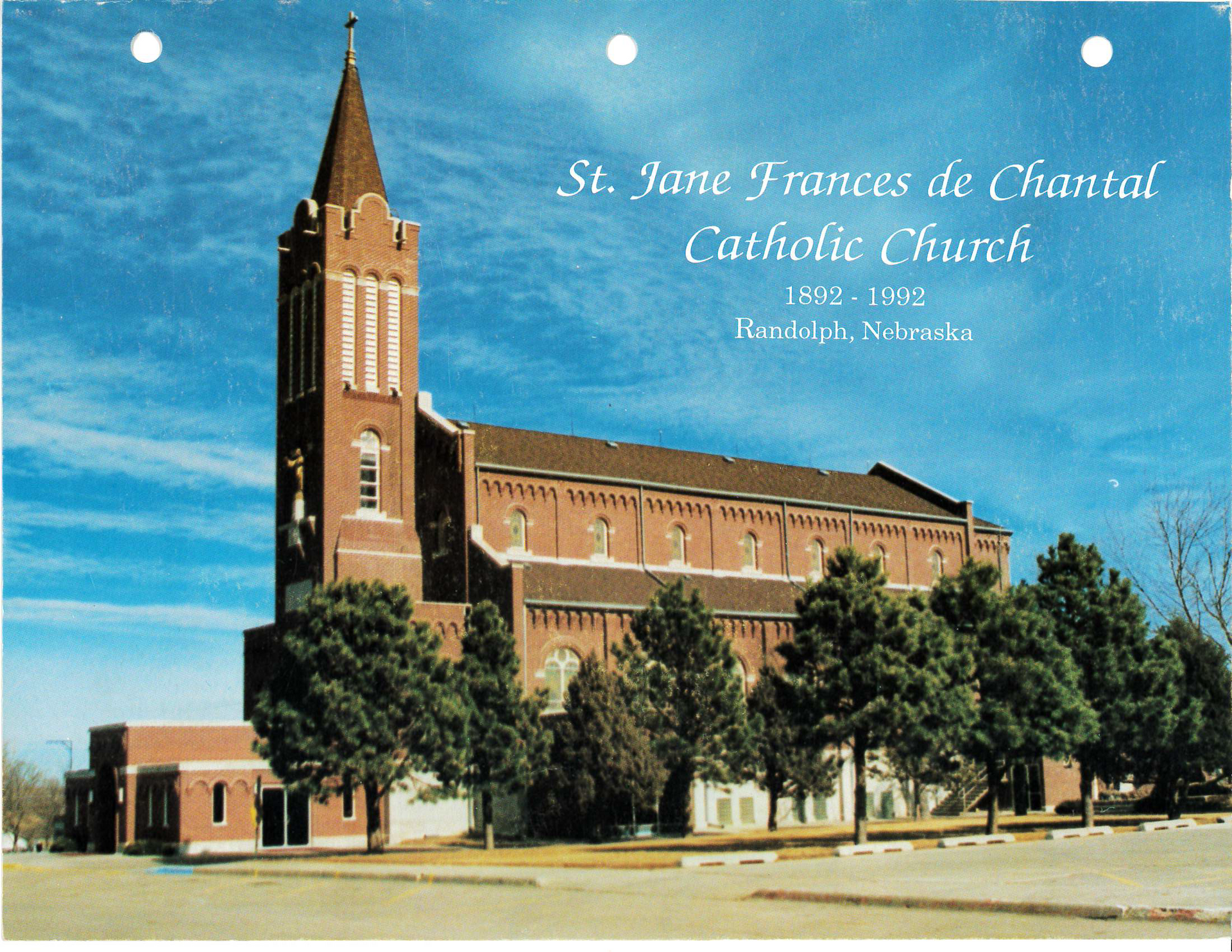
History excerpts from 100 Years of Worship and Service, St. Jane Frances de Chantal Catholic Church, Randolph, Nebraska, 1892-1992, p. 8-13.
Father Henry Loecker came on a regular basis to Randolph from his parish in Hartington in the early 1890s. Under his supervision, lots were purchased in 1891. On these lots, a small church, 24 feet by 40 feet, was built. It was completed in 1892.
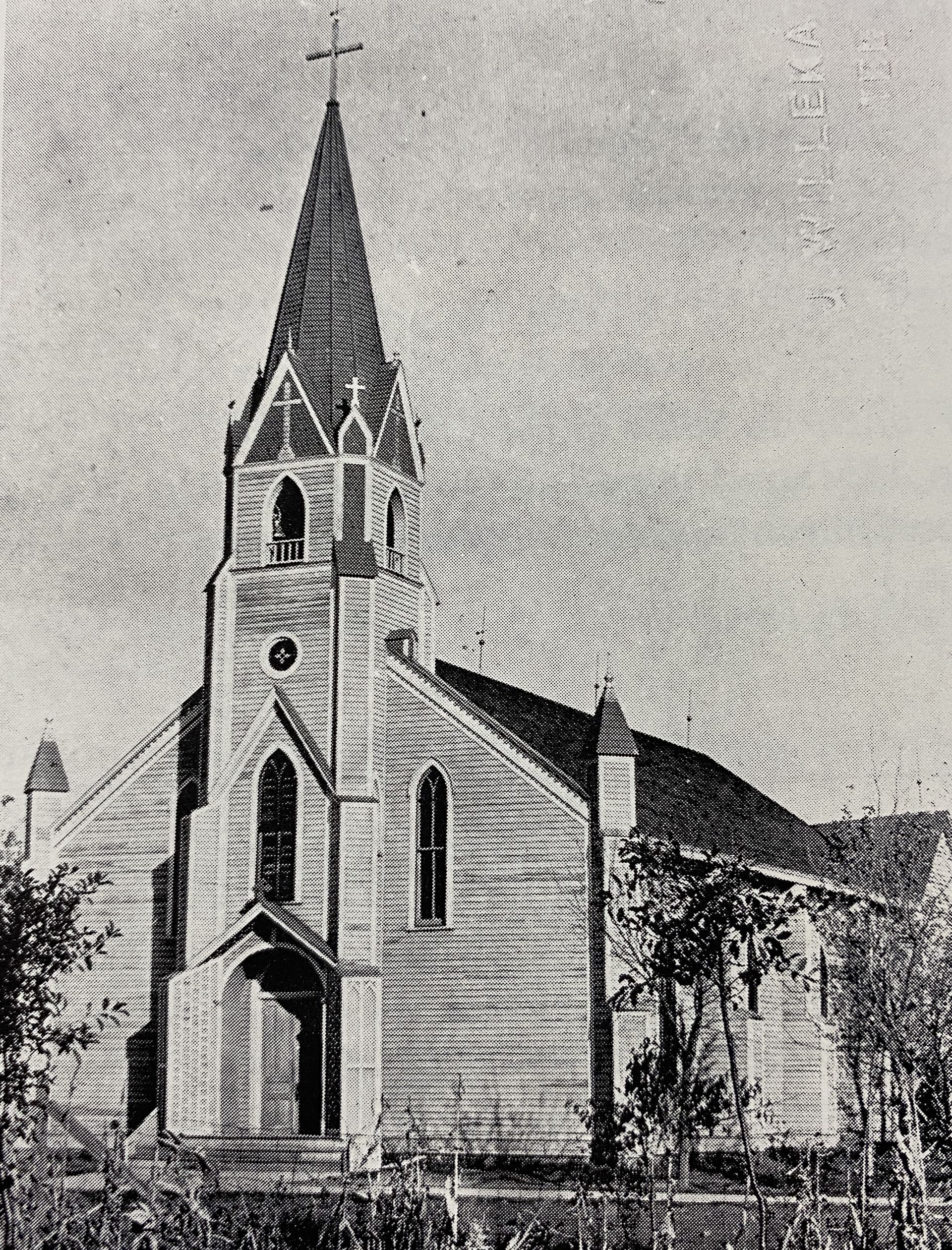
First St. Jane Frances Church 1892.
The first Mass was celebrated in the new church on Easter Sunday in 1892. Chris Nepper played the organ. Sedonia Kuhl, Zita Nepper, Mary Wurdinger, Nick Funk and Matt Schmitt formed the choir. According to records, other parishioners in 1892 were: Frank, Henry and William Abts; Frank Burke; John Dwyer; John and Mathias Kuhl; Matt Kuntz; Catherine, Frank, Henry, John, Julius, Nick and Peter Lorge; John Pimpel; Peter Reding; Jake Stukel Sr.; Peter Vinckel; Anton Widerholtz; Peter Wiese; Henry and Reiner Wintz and John Wurdinger Sr.
The parish was named after St. Jane Frances de Chantal, a French woman who lived in the seventeenth century and who founded the Religious Community of the Visitation for women to train and provide teachers for young people in her time.
The first resident pastor, Father Albert Hork, came to Randolph in 1894. The community was growing rapidly as families came from Iowa, Illinois and Indiana. "Hard times" were a result of drought, grasshopper infestation and crop failure. The small congregation found it difficult to support a pastor. Sensing this, one Sunday morning, Father Hork packed his belongings, put out the sanctuary light and announced that he was leaving. The enterprising John Lorge, who was a land agent and had been instrumental in bringing many settlers from Carroll and Shelby counties in Iowa, passed the hat and collected enough small change to buy a few groceries. Father Hork decided to give it another try.
Father A. Walbaum succeeded Father Hork in 1897. Bishop Scannell appointed Rev. Casimir Renner as the second resident priest on May 10, 1898.
By this time, additional families had arrived from Iowa, Illinois, Indiana and Europe. Father Renner saw at once that the modest church was too small and undertook the enlargement which was completed during the winter months of 1898 and 1899. The interior of the barren church was also beautified with the Stations of the Cross, an ornate high altar, statues of the Blessed Virgin Mary, St. Joseph and St. Anthony, and a handsome organ. The ambition and courage of the shepherd inspired his faithful flock to provide the backbone of a Catholic parish, a parochial school.
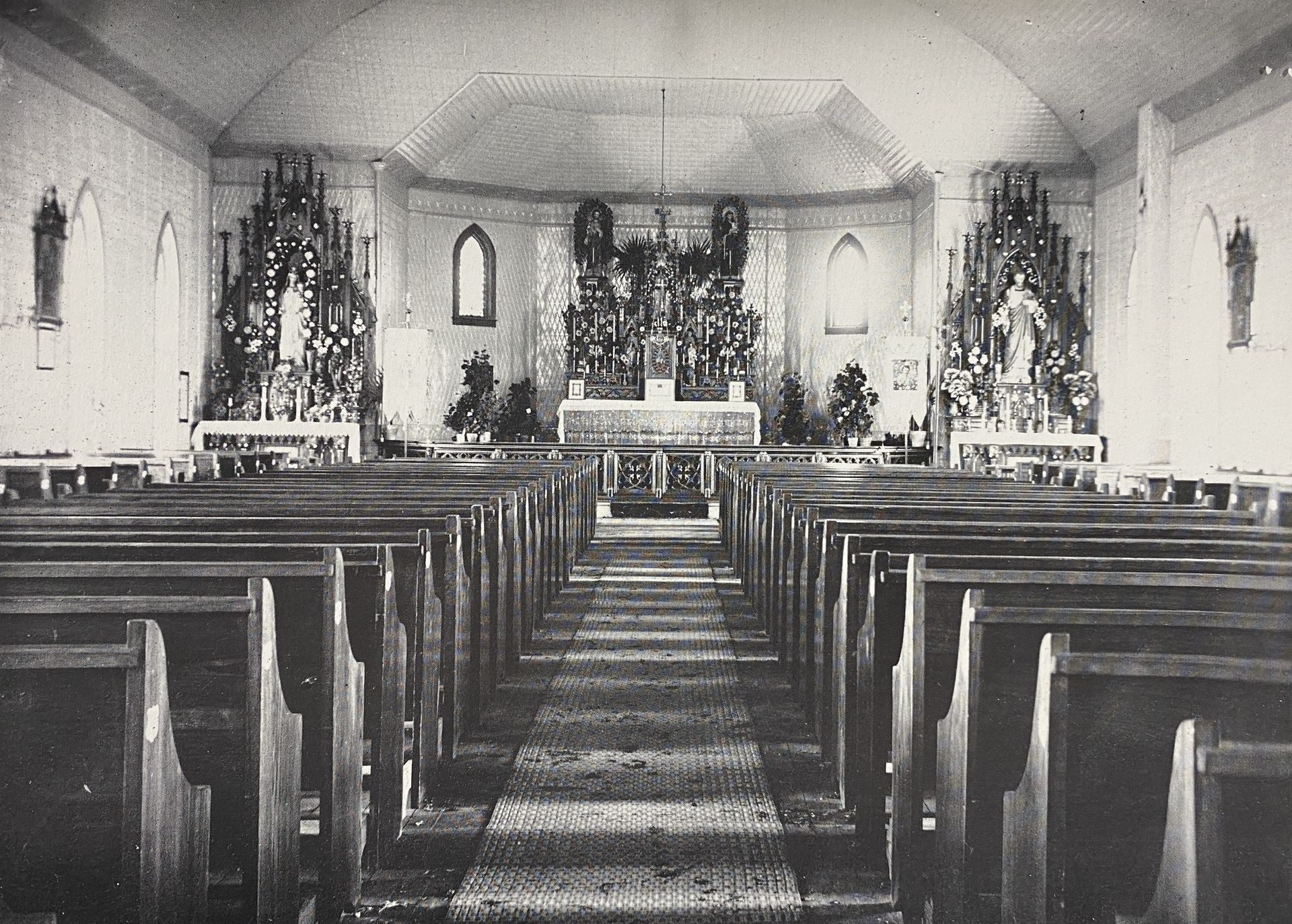
First St. Jane Frances Church interior.
Erection of the first school was begun in June 1899. It was completed at a cost of $4,000. This included equipment and living quarters for the Sisters. School opened in September with an enrollment of 140 students who came from the neighboring towns of Wayne, Coleridge, Belden and Carroll. The school was staffed by the School Sisters of St. Francis from Milwaukee, Wisconsin. St. Frances de Chantal was their first assignment in Nebraska. Sister Elizabeth was superior, assisted by Sisters Ethelberta, Leonna and Mathilda.
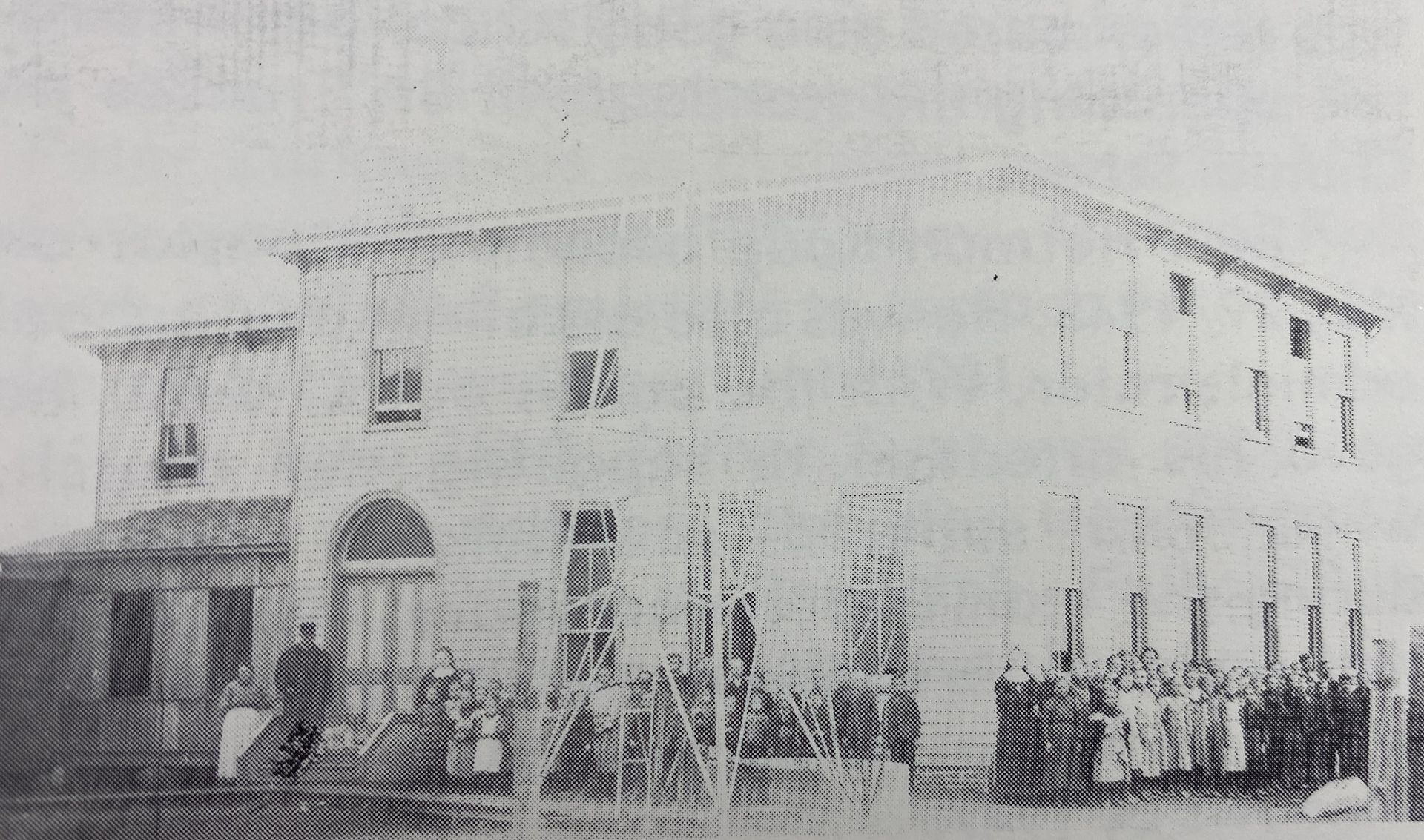
First St. Jane Frances School.
In September 1907, Father Renner was transferred to Elgin, and Rev. Kaspar Grobbel became pastor. His prime concern was the school, and he made plans to erect a new, larger institution of education. Father Grobbel's pastorate was brief. He labored hard and his health gave way under the strain. He was succeeded by his cousin, Rev. Peter Grobbel, on January 10, 1909.
On April 26, 1909, a contract was let to a Sioux City firm for the construction of a new brick school building for $17,000. The new school was dedicated on July 5, 1910. The brick building was modern and fireproof with a fire escape. The large, full basement was well-equipped with a laundry room, furnace room, a large dining room for boarders and a smaller one for the Sisters. The large kitchen was well-equipped with a pantry and serving room. The first floor main entrance had a wide hall from which the stairway rose. There were four large, well-lighted classrooms on the main floor. The second floor had two classrooms, music room, chapel and living quarters for the Sisters. On the third floor were two dormitories for out-of-town pupils. The floors were well-finished hard maple, and the woodwork was a selected hard pine.
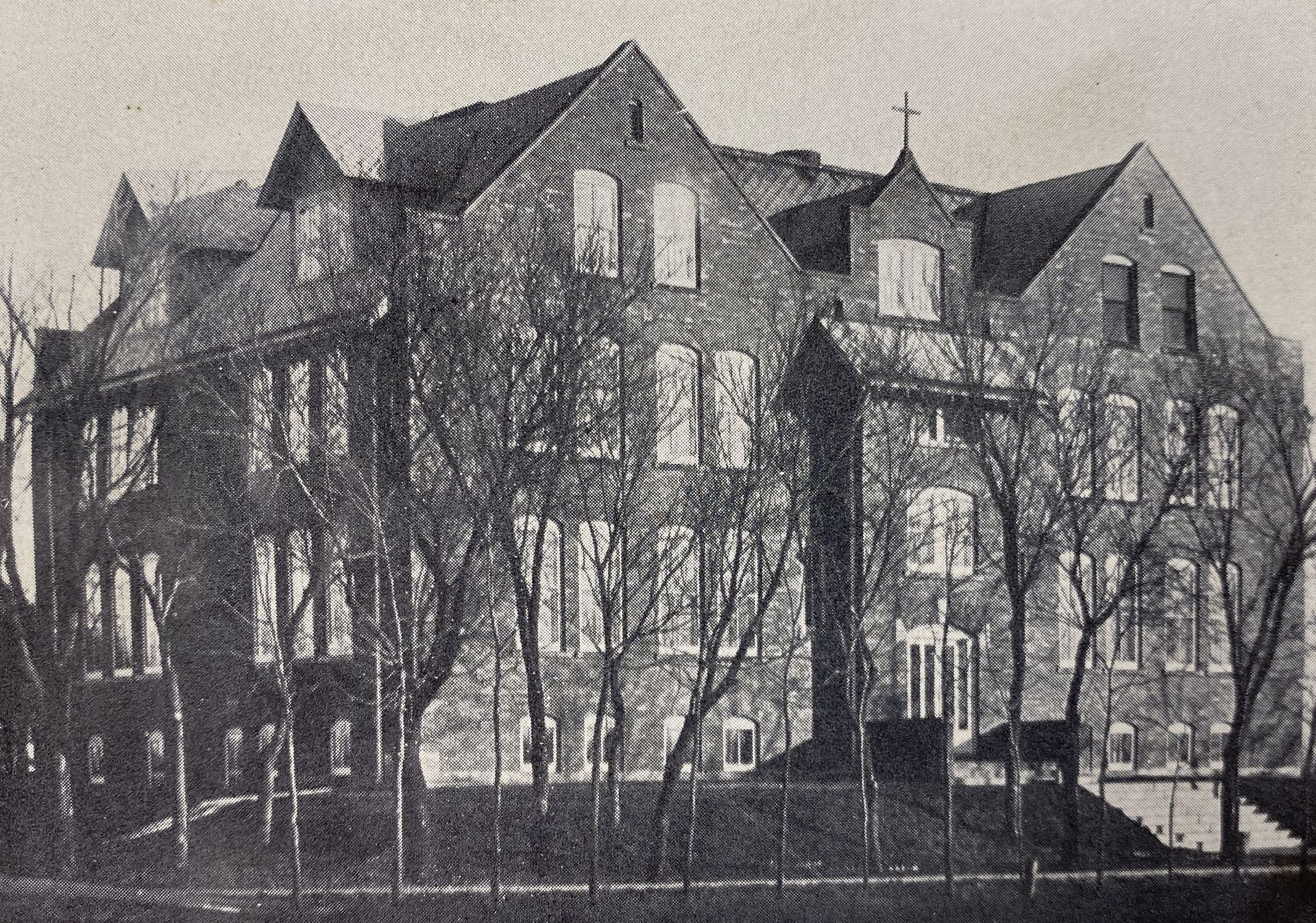
Above: Second St. Jane Frances School. Below: School Chapel.
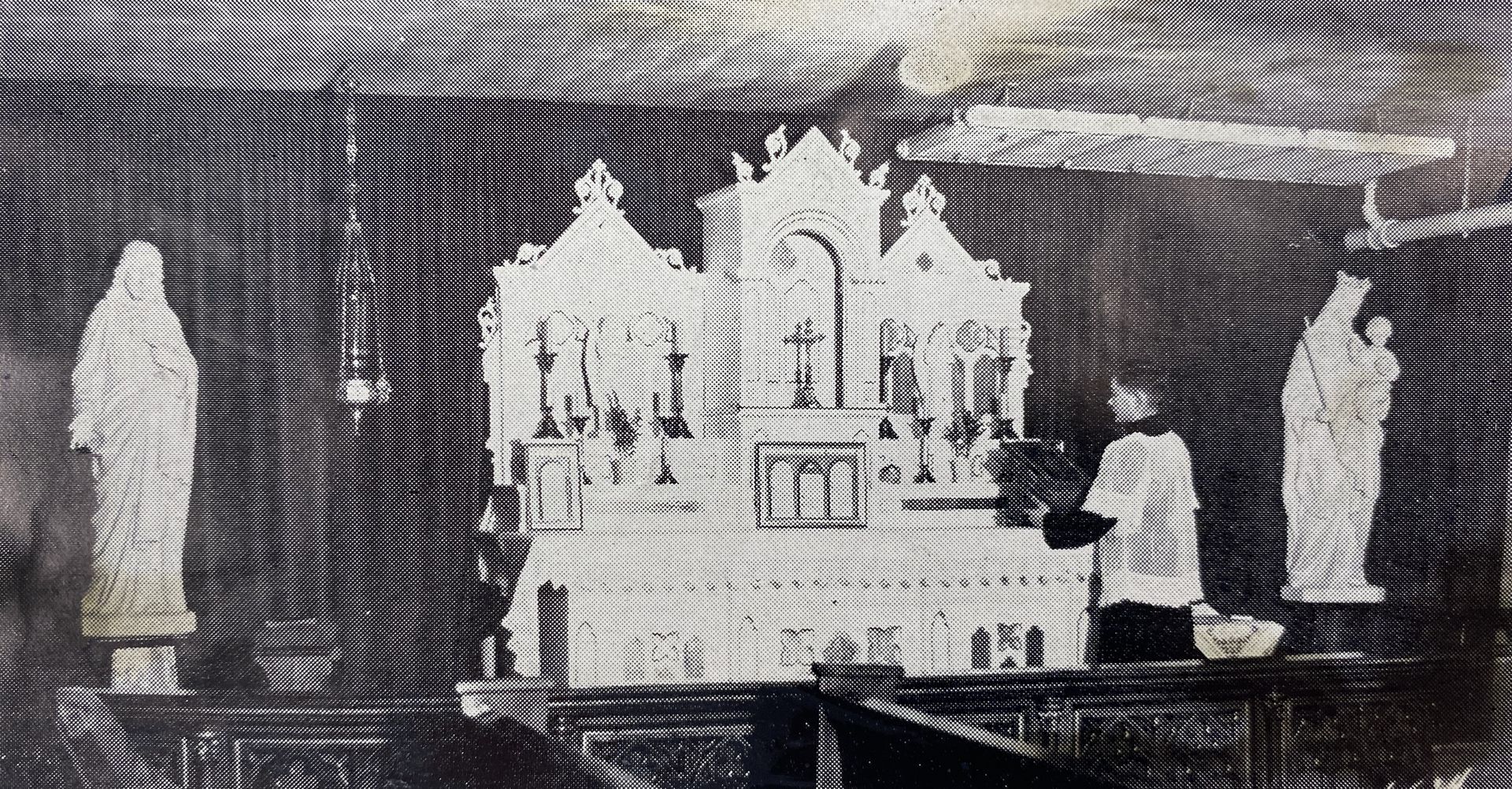
Father Peter Grobbel firmly believed and thoroughly subscribed to the adage, "Spare the rod and spoil the child." Many tales are told of the parish horse barn, which was located on the north edge of the church property, serving as a woodshed for deserving or suspected culprits.
On May 11, 1913, a new pastor, Rev. Ferdinand Peitz, arrived. A year later, he was assigned to West Point.
In 1914, Rev. Bernard Lordemann became pastor. Again the school was his first consideration. He opened St. Frances de Chantal High School that same year. The 1914-15 faculty consisted of Father Lordemann and Sister Julia and Sister Lautencia who taught during the 1916 through 1918 school years. In 1920, the number of teachers assisting Father Lordemann increased to three and, in 1922, to four Sisters.

Second St. Jane Frances Church 1917.
From 1916 through 1919, the parish worked to secure the money needed to build a new church, since the congregation had grown too large for the wooden structure. In 1917, the present Romanesque brick structure was erected with a comfortable seating capacity for 600 persons in the nave. The Carrara marble altar, placed under a fixed canopy, was imported from Italy at a cost of $48,000. The total cost of the church, including furnishings, was $75,000.
On Sunday, June 30, 1918, St. Frances parish gathered for the first Mass in the new church. The first couple to be married after the Carrara marble altar was installed was Robert Aschoff and Angeline Thieman on December 29, 1918.
Father Lordemann, a gentle man, remained until 1930 when he was promoted to monsignor and transferred to Hartington. The parishioners were happy for him but regretted to see him leave. He was succeeded by Rev. Bernard Teves who courageously carried on the traditions of his predecessors during the trying Depression years. Father Teves tried to save the parish expenses by celebrating Mass in the church basement to save heat and fuel during the winter months. Four years later, in 1934, Father Teves was replaced by Rev. Joseph Falke. The Depression years, with drought, grasshoppers, dust storms and crop failures, still plagued the farmers. It was difficult to meet running expenses and pay interest on the parish debt. By 1943, when Father Falke was transferred to head the Creighton, Nebraska, deanery, the parish debt had been paid. He was remembered as a good school administrator, upgrading the standards of St. Frances de Chantal School.
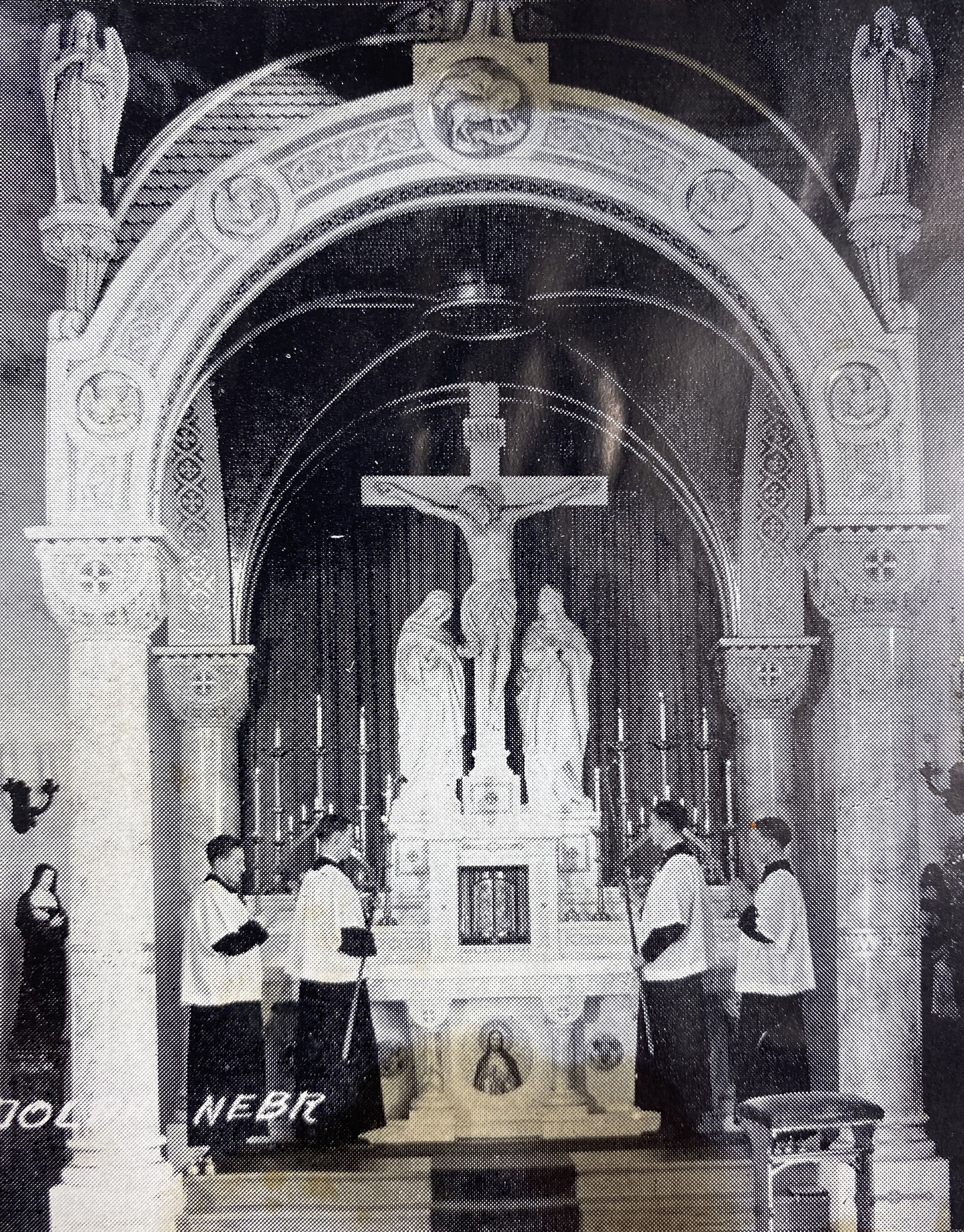
Second church interior with Carrara marble altar and fixed canopy.
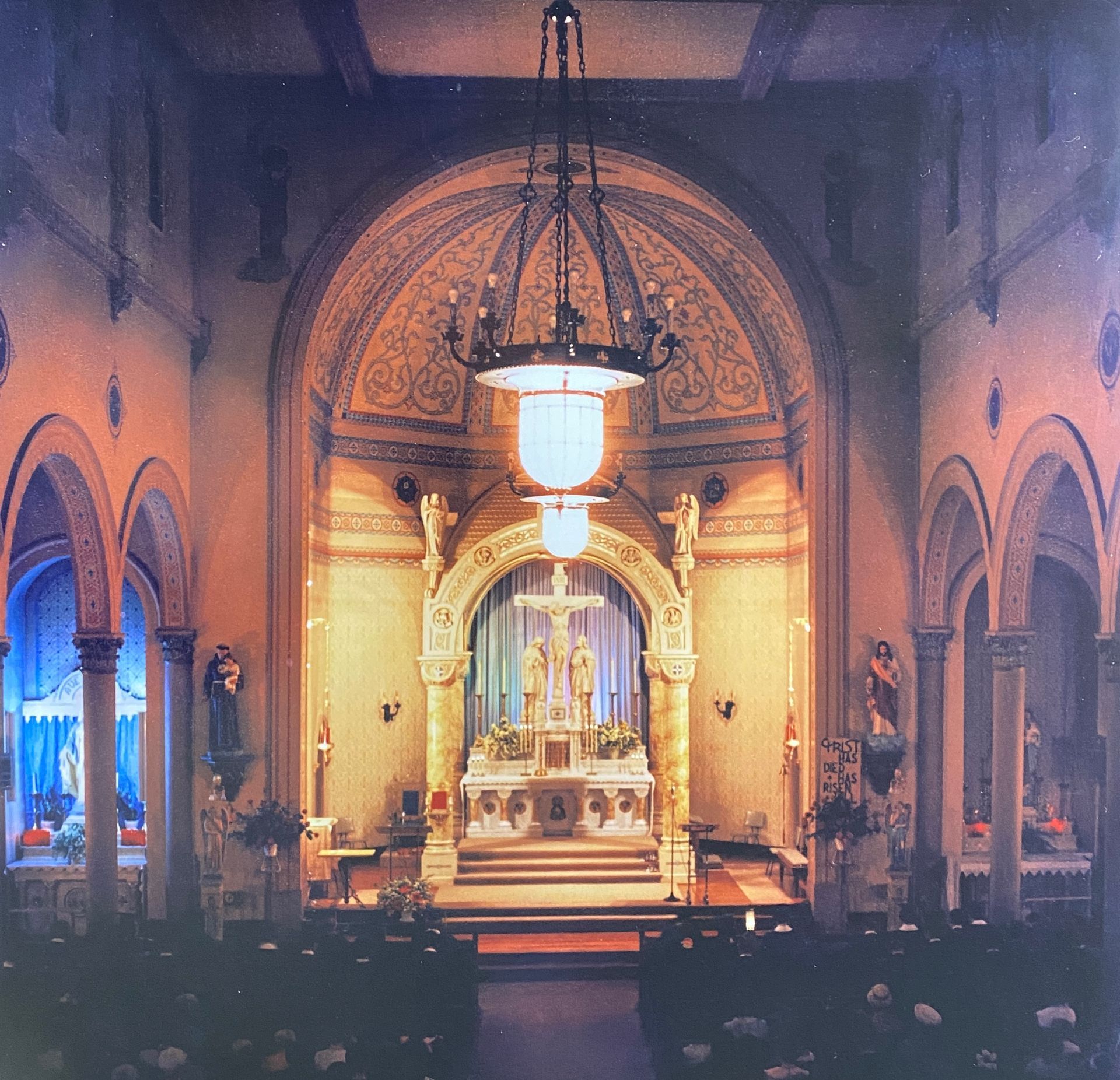
Rev. Herman Kaup became the pastor on May 29, 1943. He was also excellent as a school administrator. With the parish out of debt, he gave his attention to repairing the church, which had suffered considerable damage during the lean Depression years. The church was repaired throughout and the interior decorated with the installation of new art glass windows by 1947.
In 1949, the old, one-story rectory was replaced with the spacious residence, formerly owned by Dr. G. E. Hartman and which was moved across town to church property. Living quarters for a housekeeper were added to it. The dwelling was then well-adapted to provide a functional rectory for the pastor and assistant.
Father Norbert Boland was the first assistant pastor, appointed in 1946. At this time, Our Lady of Sorrows Church at Carroll, formerly served by St. Mary's at Wayne, became a mission of Randolph.
Three years later, in 1949, Rev. Paul Fangman succeeded Father Boland as assistant pastor. Father Boland was appointed pastor of the rural parish of Clyde, Nebraska.
Recognizing Father Kaup's sterling qualities of administration, Archbishop Gerald Bergan transferred him to the deanship of West Point on January 3, 1951.
Listen to the history of Our Lady of Sorrows, Carroll, as part of Fr. Vogel's Faith on the Frontier series.
Rev. Raymond Auer was appointed to succeed Father Kaup. During his pastorate, improvements and repairs continued to be made. In 1952, the paving of the street parking facilities were completed. In 1953, the school was rewired with the installation of instant-starting fluorescent lights and a new steam boiler.
Rev. Paul Fangman was replaced by Rev. Peter Zarkauskas as assistant pastor in 1952. Five years later, in 1957, Rev. Michael Kelly was appointed assistant to replace Father Zarkauskas. He remained until 1961.
In June 1960, Father Auer was appointed to head the deanery and was transferred to Hartington. While in Randolph, Father Auer was instrumental in organizing perpetual adoration in the parish.
A convent for the Sisters was erected during his pastorate. The convent was completed in May 1957.
Rev. Otto Buehler followed Father Auer as pastor in June of 1960. In 1961, Rev. Daniel Galas replaced Father Kelley as assistant and remained until 1964. The next assistant was Rev. Emmett Meyer who served until 1968.
During Father Buehler's tenure, a new school was erected at a cost of $341,000. Building of the school began in 1963 and it was open for the 1966-67 term. The school closed during the summer of 1970. The public school district purchased the school, including property on which the rectory was situated. The public and parochial schools combined in the fall of 1970. The last assistant pastors were Rev. Alfred Moseke, 1968-69, and Rev. Robert Eimers, 1969-70.
After selling the property to the public school in 1970, it was necessary to relocate the rectory. The Albert Kuhl residence, located across the street from the church, was purchased to serve as the rectory. The old rectory was sold to Mr. and Mrs. Vernon Loberg in October 1971 for $1,275. It was moved to the west edge of town.
Due to Father Buehler's failing health, he was assisted by Rev. Anthony Tresnak from the Hartington parish and Father Thomas Allen, O.S.B., from Elkhorn. After a lengthy illness, Father Buehler died on January 11, 1971.
Rev. Thomas Furlong was appointed pastor following Father Buehler's death. He remained until 1972 when he was appointed pastor of Sacred Heart Church in Omaha. During Father Furlong's tenure, the parish council was organized. It is comprised of nine members. Other committees organized were education, liturgy and activities. Renovation of the church interior was also initiated by Father Furlong.
Because of the absence of a Catholic school, a Confraternity of Christian Doctrine (CCD) education program was introduced. It has been successful, with parish members serving as volunteer teachers under the direction of a coordinator. The present coordinator is Janet Groen.
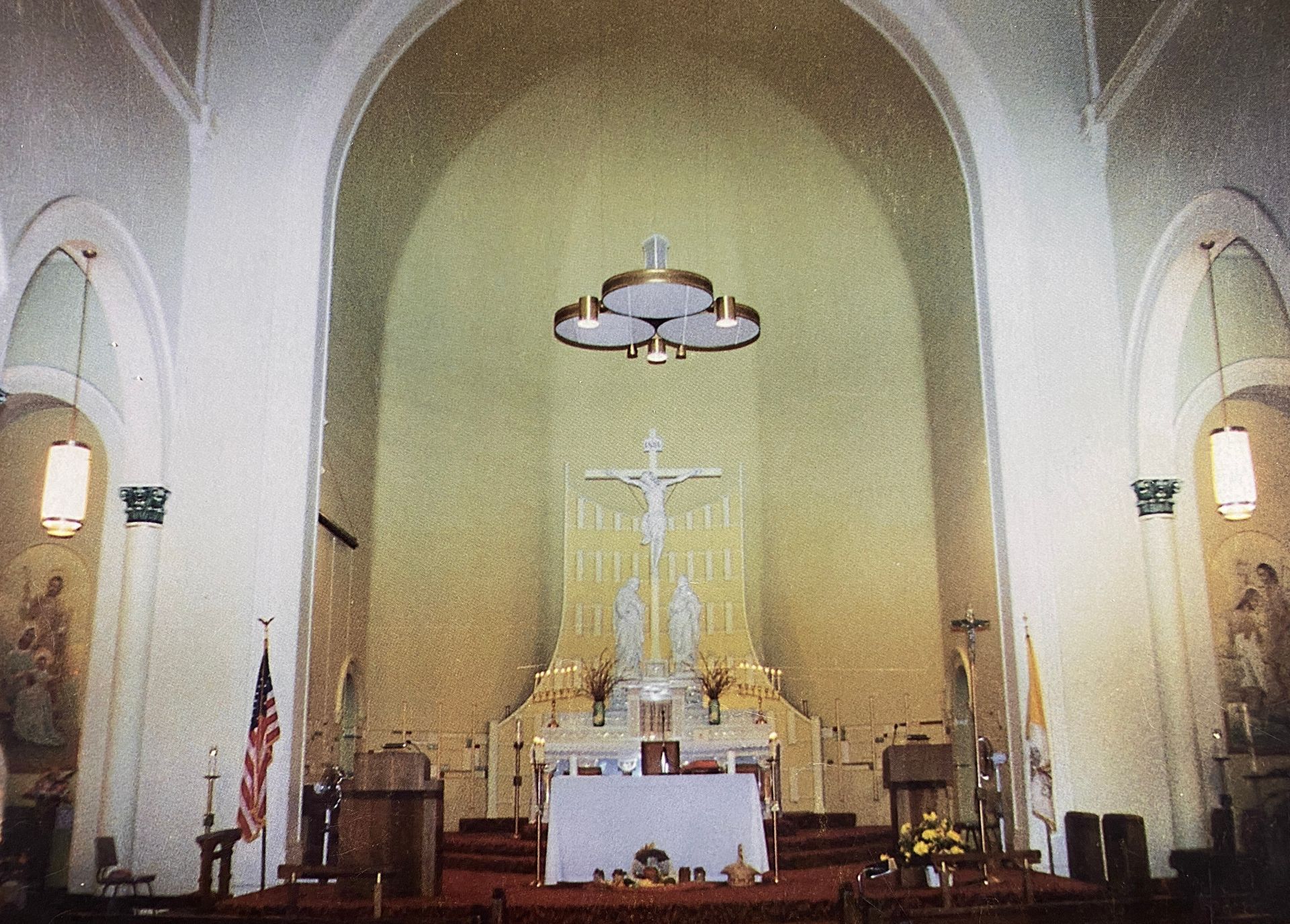
St. Jane Frances Church 1970s redecoration.
Rev. Benedict LaRocque was appointed to succeed Father Furlong in 1972. The redecorating project of the inside of the church and extensive repairs to the church were continued after Father LaRocque came to St. Frances. A spacious new office and living quarters for a housekeeper were added to the recently-purchased rectory.
Schettler Studios of Carroll, Iowa, was awarded the contract for repairing, renovating and painting of the church which was declared structurally sound by Gene Olson, architect. The council voted in favor of making necessary repairs. The new roofing was done by Friend-Pike Roofing Company of Sioux City at a cost of $8,517. This included heavyweight (380-pound) shingles, tarring of flat decks, caulking, sheet metal work and labor, steeple not included.
The sound system in the church was replaced by new equipment, installed by Esco Electronic Supply Company of Omaha at a cost of $2,814.
St. Frances boasted a new look with over-all redecorating, new carpeting, sanctuary furniture, lighting fixtures and revamped new pews with kneeler pads. A new mother's room was added, as well as murals which graced the Holy Family altar and baptistry.
On February 18, 1973, parishioners of St. Frances gathered to celebrate the renovation of their church interior and exterior. In addition to the congregation of St. Frances, the Archbishop and former pastors joined to mark the end of a long period of planning to make the church the beautiful place of worship it now is.
With St. Frances no longer having an assistant pastor, the mission at Carroll closed in the fall of 1973. The parishioners in Carroll transferred to St. Mary's in Wayne and St. Frances in Randolph.
In the fall of 1975, the parish hall was completely remodeled. This project included enlarging and remodeling the kitchen area, paneling and carpeting the dining area, lowering the ceiling, purchasing all new dining room furniture, and changing the steam heating system in the entire structure of the church to a forced air system of heating and cooling.
On April 25, 1976, an open house was held to celebrate the completion of the newly- enclosed entries of the church. The main entry addition to the west served to enclose the stairs, protecting them from the weather. The south entry included an elevator-lift from ground level to the church proper.
These renovations began under the direction of Father Furlong and were completed during the tenure of Father LaRocque. Father LaRocque served the parish from 1972 until 1977 when he was transferred to O'Neill. Rev. Roland Peschel, a kind, congenial man, was pastor from 1977 until 1982 when he was transferred to serve the parish at O'Neill.
On October 28, 1979, Vincent Schmit was ordained deacon. The Rev. Mr. Schmit has been a valuable asset to the parish. He helps take pressure off the priest's heavy load. Among his many services, Deacon Schmit conducts a communion service at Colonial Manor each Sunday after the 10 o'clock Mass.
By 1981, it was obvious that there was a need for a new organ. After a vote of the parish, it was decided to purchase a new pipe organ to replace the electronic tubular type which had been used for a period of 30 years. At a cost of $49,765, a beautiful new pipe organ, which was especially designed for St. Frances, was purchased by the parishioners. It was installed in February of 1985 and dedicated on October 27, 1985.
Rev. James Ryberg succeeded Father Peschel, arriving in June of 1982 and remaining until the summer of 1985 when he was appointed pastor at St. Leonard's Church in Madison.
The next pastor was Rev. Richard (Rick) Arkfeld who arrived in June of 1985. The following year, in February of 1986, Father Arkfeld was diagnosed as having lung cancer. Because of his serious illness, his 25th anniversary, scheduled for June of 1987, was celebrated three months early, in March of 1987. Father Rick was appointed to a small rural parish, St. Anthony's, at St. Charles, Nebraska, in June of 1988. Presently, he is pastor of St. Michael's Church in Coleridge.
A contract for the renovation-electrification of the three existing bells on the church was drawn up on January 19, 1987. Equipment and installation was furnished by the I. T. Verdin Company of Cincinnati, Ohio. The total cost was $12,670.
In the fall of 1987, the parish introduced the Renew program which officially opened on October 11, 1987. The program consisted of five fall and spring seasons, six weeks per season, ending in the fall of 1989. The parishioners who completed the five seasons felt that it was a rewarding experience.
Rev. Donald Stortz was appointed to replace Father Rick in June of 1988. During Father Don's tenure, the parish celebrated the silver jubilee of his ordination on June 4, 1989. The liturgy involved parishioners, friends and relatives. Father Don remained until June 1991. As in previous years, the parish regretted losing its pastor.
Rev. Jack Hebert of Butte was appointed to replace Father Don in June of 1991. Father Jack, a kind and gentle man, is an accomplished musician. He presented an organ concert in the city auditorium in December 1991. The hall was filled to capacity and the program was enjoyed by all.
(100 Years of Worship and Service, St. Jane Frances de Chantal Catholic Church, Randolph, Nebraska, 1892-1992, p. 8-13)
Also during Father Jack’s tenure St. Jane Frances Parish celebrated their 100th Anniversary as a parish.
Rev. Wayne Schlautman was appointed to succeed Father Jack in June of 1992. He served the parishioners of St. Jane Frances de Chantal until June of 1997. During his tenure the interior of the church was completely repainted and the sanctuary was remodeled.
Rev. Ronald Battiato was appointed to succeed Father Wayne in June of 1997. He served the people of St. Jane Frances until June of 2007. When Father Ron came to serve as pastor he brought with him his own personal housekeeper, Chantelle Schmit. While Father Ron was here Doug Tunink was ordained a permanent deacon in 2001 and Deacon Vincent Schmit passed away on November 27, 2006, so now our parish is only served by one deacon. Father Ron was assigned senior assistant pastor of St. Patrick’s in Fremont in June 2007 at which time Rev. John S. Andrews was appointed to succeed Father Ron.
Father John is currently the pastor of St. Jane Frances de Chantal of Randolph and the pastor of St. Mary’s of the Seven Dolors of Osmond. He currently resides in Osmond. It was a big change for the people of St. Jane Frances and St. Mary’s to share a pastor. It is a good thing that Father John is young, so he is able to keep up with all the activities of both parishes. Beginning in February 2009, St. Jane Frances repainted their sanctuary which was completed in time for Easter Sunday, April 12, 2009, Mass. The painting was done by Reeder Originals, of Norfolk, Nebraska. Karl and Brenda Reeder, are the owners and did the painting. The four canvas paintings show the life of St. Jane Frances de Chantal from the death of her husband until her death. The Holy Family and Baptismal canvas at the front of church were also painted at this time as well as the side walls of the church. The new painting gives the church a cathedral like look.
(2009 Update)
| Pastor | Years |
|---|---|
| Fr. Albert Hork | 1894-1897 |
| Fr. A Walbaum | 1897-1898 |
| Fr. Casimir Renner | 1898-1907 |
| Fr. Kaspar Grobbel | 1907-1909 |
| Fr. Peter Grobbel | 1909-1913 |
| Fr. Ferdinand Peitz | 1913-1914 |
| Fr. Bernard Lordemann | 1914-1930 |
| Fr. Bernard Teves | 1930-1934 |
| Fr. Joseph Falke | 1934-1943 |
| Fr. Herman Kaup | 1943-1950 |
| Fr. Raymond Auer | 1951-1960 |
| Fr. Otto Buehler | 1960-1970 |
| Fr. Thomas Allen OSB | 1970-1970 |
| Fr. Anthony Tresnak | 1970-1970 |
| Fr. Thomas Furlong | 1970-1972 |
| Fr. Benedict LaRocque | 1972-1977 |
| Fr. Roland Peschel | 1977-1982 |
| Fr. James Ryberg | 1982-1985 |
| Fr. Richard Arkfeld | 1985-1988 |
| Fr. Donald Stortz | 1988-1991 |
| Fr. Jack Herbert | 1991-1992 |
| Fr. Wayne Schlautman | 1992-1997 |
| Fr. Ronald Battiato | 1997-2007 |
| Fr. John Andrews | 2007-2011 |
| Fr. Michael Swanton | 2011-2015 |
| Fr. Tim Forget | 2015-2022 |
| Fr. Kevin Vogel | 2022-2023 |
| Fr. Owen Korte | 2023-Present |
| Associate | Years |
|---|---|
| Fr. Norbbert Borland | 1946-1949 |
| Fr. Paul Fangman | 1949-1952 |
| Fr. Peter Zarkauskas | 1952-1957 |
| Fr. Michael Kelly | 1957-1961 |
| Fr. Daniel Galas | 1961-1964 |
| Fr. Emmett Meyer | 1964-1968 |
| Fr. Alfred Moseke | 1968-1969 |
| Fr. Robert Eimers | 1969-1970 |
| Fr. Kevin Vogel | 2023-Present |
St. Frances de Chantal Church in the southwestern Cedar County community of Randolph is a graceful modified Romanesque structure whose appearance has undergone countless remodeling and maintenance projects.
Like many Nebraska communities, Randolph was initially served by visiting priests on an irregular basis. Parish records indicate that the first Mass in Randolph on April 9, 1889. Father Charles Mugan first came on March 19, 1889, to baptize the infant daughter of Mr. and Mrs. John Lynn. He came again to offer the first Mass in Randolph on April 9, 1889.
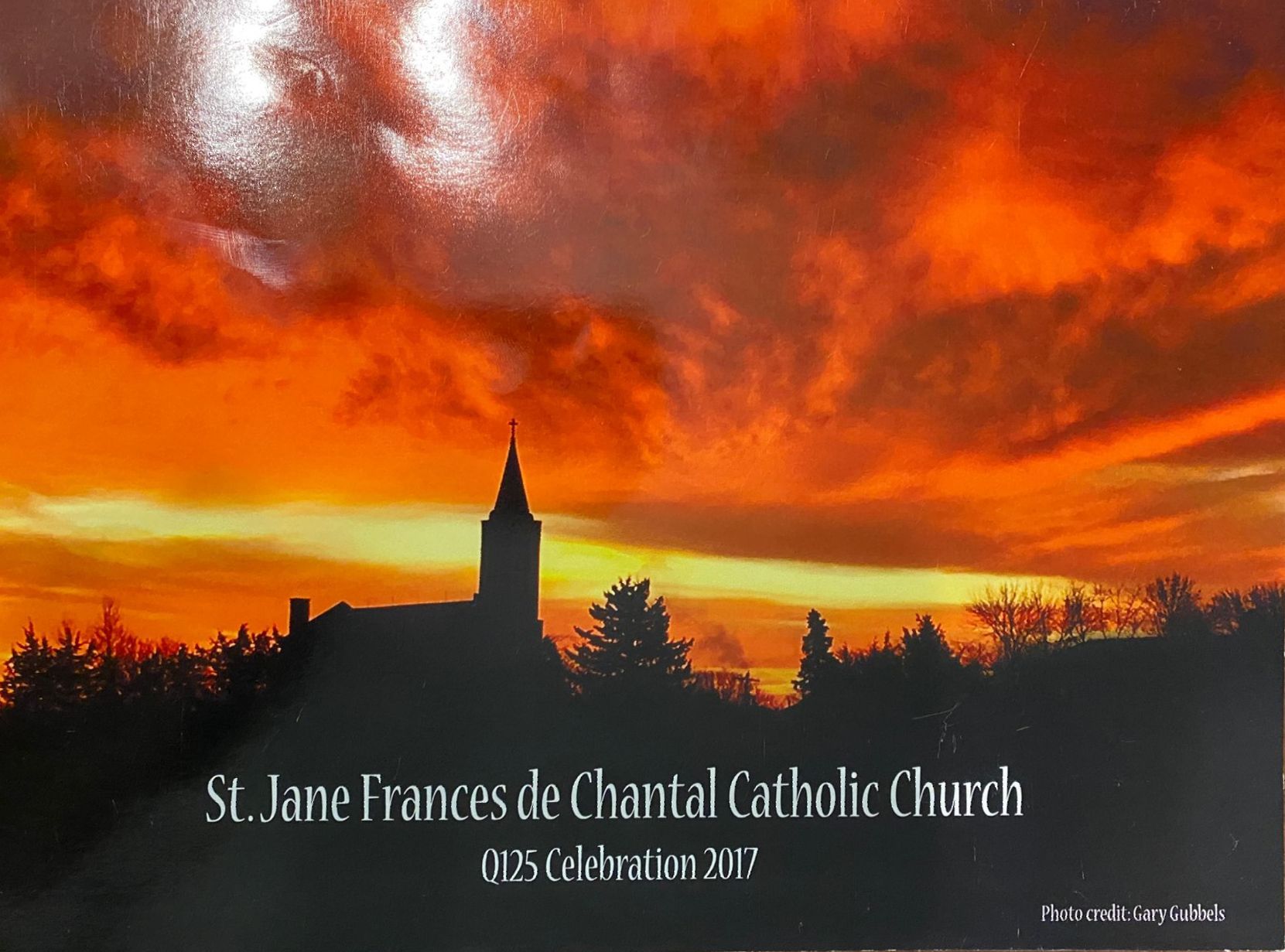
History excerpts from St. Jane Frances de Chantal Catholic Church, Q125 Celebration 2017.
Later Father Henry Loecker made more-or-less regular visits from his post at Hartington. The "church" in those days was Nick Lorge's Father Loecker's server. grocery store and the "altar" consisted of empty crates. John Nepper, who was to become one of four priest-sons of the parish, was Father Loecker’s server.
Under Father Loecker's leadership, several lots were purchased in 1891, and during the ensuing year a 24x40 ft. church was built. The first Mass was offered in it on Easter 1892.
In 1894, even before the little parish could provide a rectory, Father Albert Hork came as the first resident pastor. Even though a home had been built for him in 1893, drought and grasshoppers kept his parishioners from providing him anything but the barest sustenance. One Sunday he packed his bag; blew out the sanctuary lamp and announced he was leaving. The enterprising John Lorge, who as land agent had been instrumental in bringing many of Randolph's settlers from Carroll and Shelby counties in Iowa, passed the hat and collected enough small change to buy Father Hork a few groceries. The pastor unpacked and decided to give it another try.
Only after the parish had established both an elementary and high school was the building of the present church undertaken in 1917. At that time the present Romanesque brick structure was erected with a seating capacity of 675 in the nave. The Carrara marble altar was imported from Italy. At a cost of $48,000, not including heating, lighting, stained glass or furnishings, the church was completed; total cost including furnishings would be $75,000. On Sunday, June 30, 1918, St. Jane Frances Parish gathered for their first Mass in the new church.
Despite dust, drought and depression, the parish met its financial obligations during the ensuing years-but the attractive brick church was somewhat neglected in the process. When all debts were paid in the 1940's, however, the church was thoroughly repaired and decorated.
In 1973, on February 18, parishioners of St. Jane Frances Church gathered to celebrate the renovation of their church interior. The congregation of St. Jane Frances along with the Archbishop and former priests marked the end of a long period of planning to make the church a beautiful place of worship. Included in this renovation was the addition of the mother's room and the murals that grace the Baptistery and Holy Family altars.
In the fall of 1975 the Parish Hall was completely remodeled and the changing of the steam heating system in the entire church structure to a forced-air system of heating and cooling. On April 25, 1976, an open house was held to celebrate the completion of the newly enclosed entries on the church. The main entry addition to the west served to enclose the stairs, protecting parishioners from the weather; the south entry included an elevator/lift from ground level to the church proper.
By 1981 it was obvious that there was a need for a new organ. The parish voted to replace the thirty-year-old electronic tubular-type with a pipe organ. A beautiful new pipe organ designed especially for St. Frances was purchased of $49,765. It was installed in February 1985, and dedicated on October 27, 1985.
St. Jane Frances de Chantal celebrated its parish centennial in 1992 with various parish activities throughout the year.
Our most recent remodeling project was completed in 1995.
(St. Jane Frances de Chantal Catholic Church, Q125 Celebration 2017)
Historical Timeline of St. Jane Frances Catholic Church, Randolph, Nebraska
- 1891-1892 Built Church - 24'x40'. No explanation for the church's name.
- 1898-1899 Expanded exterior and furnished interior with an organ, Stations of the Cross, high altar, Blessed Virgin Mary, St. Joseph and St. Anthony Statues
- 1917-1918 Built current brick church to hold 600 people comfortably
- 1943-1947 Repaired interior church and installed stained glass windows
- 1971-1976 Interior improvements: new carpet, sanctuary furniture, lighting fixtures, revamped new pews with kneeler pads, a new mother's room and new murals (Holy Family and Baptism altars). Main entry addition to the west to enclose the stairs and an elevator lift from ground level to the church proper. Parish hall was completely remodeled; enlarging and remodeling the kitchen area, paneling and carpeting the dining area, lowering the ceiling and purchasing all new dining room furniture and changing the steam heating system in the entire structure of the church to a forced air system of heating and cooling.
- 1987 Renovated and electrified the three existing church bells
- 1992-1997 Repainted interior and remodeled sanctuary
- 2003 Installed handicap unisex bathroom in main entry, new lift - goes up to church or down to church basement, replaced worn- out/defective condenser/blower units of AC, installed protective stained glass window coverings
- 2005 Installed carpet in basement, on steps and on entry steps in the main/south entrance
- 2009 Repainted the sanctuary, which included four canvas paintings showing the life of St. Jane. The Holy family and Baptismal canvas, as well as the side walls of the church were painted.
- 2011 Remodeled "Bride's Room"
- 2012 Constructed sidewalks/handicap parking in front of church, added a roundabout, installed outdoor light poles on north and east sides, installed new electronic bell system
- 2013 Installed new roof, replaced entryway carpet, refurbished entryway restrooms, added handicap restroom in basement
School
- 1899 Built wood building with living quarters for School Sisters of St. Francis, 140 students enrolled
- 1909-1910 Constructed new larger brick building with living quarters for Sisters and boarders
- 1914 Began St. Frances de Chantal High School
- 1953 Added fluorescent lights and new steam boiler
- 1963-1966 Constructed new brick building
- 1970 Closed school
Rectory
- 1949 Replaced one-story rectory with residence formerly owned by Dr. G.E. Hartman which was moved to church property. Living quarters for a housekeeper were added.
- 1971 Purchased the Albert Kuhl residence across the street from the church
- 1972 Added an office as well as living quarters for a housekeeper
- 2003 Shingled roof
- 2007-2011 No priest resides at the rectory
- 2012 Updated lawn sprinkler system
Convent
- 1957 Constructed brick building
- 1970 Renamed "CCD Center", for religious education classes
- 2012 Painted interior, replaced windows/door
(St. Jane Frances de Chantal Catholic Church, Q125 Celebration 2017)
A Brief History by Fr. Casimir Renner, 1907
In the year 1889, March 19th, Rev. Father Mugan, at that time stationed in Wayne, Nebr., made his first visit to Randolph. On this occasion he administered baptism to Margaret Lynn, infant daughter of John Lynn, engineer on C. St. P. M. & O. railroad. The second trip the Reverend Father made to Randolph was on April 9th, 1889. This time he celebrated Mass at the house of Mrs. Lynn, the first time the Holy Sacrifice was offered at Randolph. About six people were in attendance. After this Rev. Father Wallace, who has since returned to his Fatherland, England, made some visits.
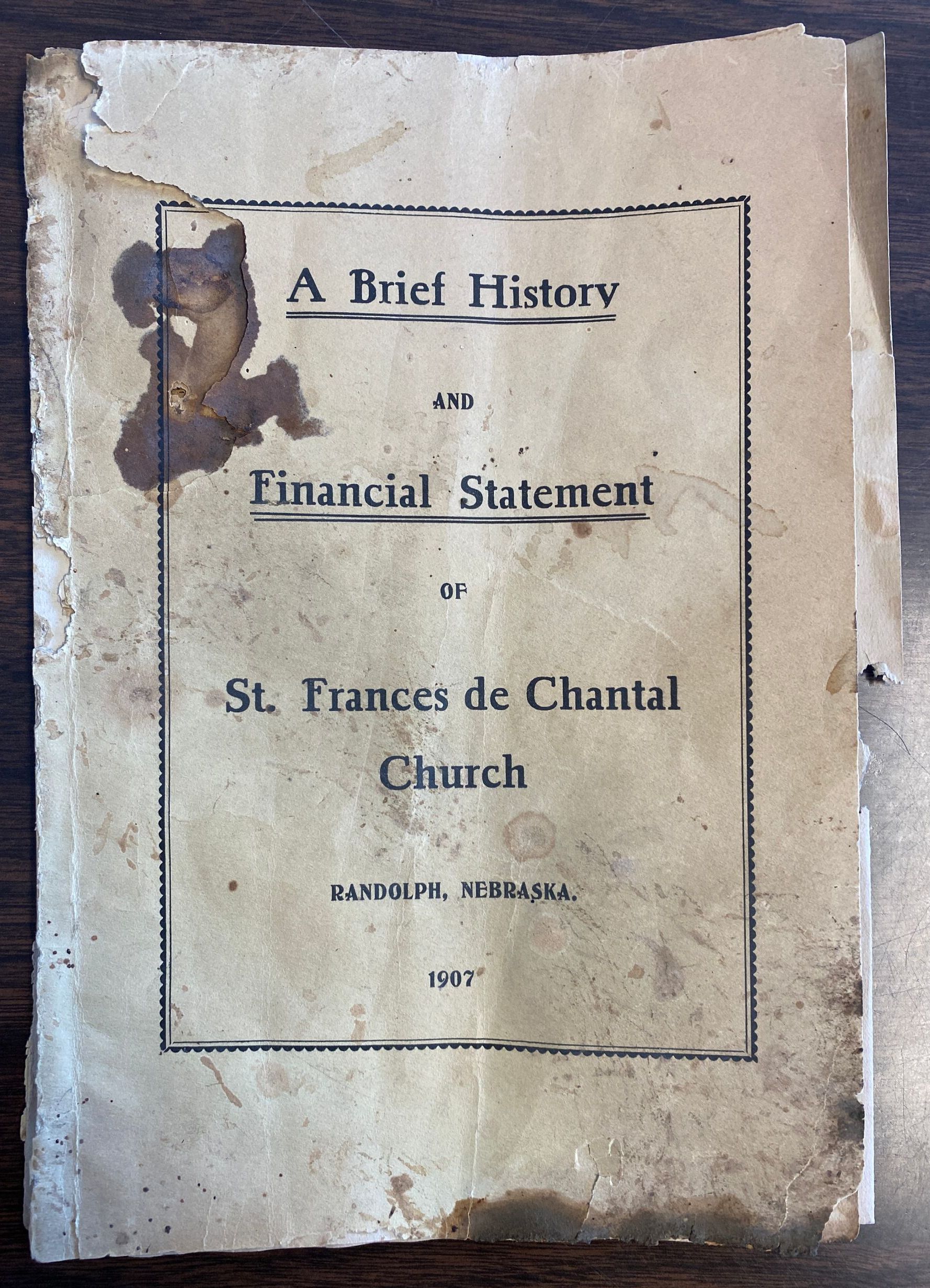
History excerpts from C. Renner, Pastor, A Brief History and Financial Statement of St. Jane Frances de Chantal Church, Randolph, Nebraska 1907.
It was about this time when the Catholics became more numerous. They having obtained more knowledge of the fertility of the soil hereabouts, came mostly from Iowa to make their home in this part of Nebraska. Soon a Catholic Mission was established and attached to the Hartington congregation. Randolph Catholics were now visited by Rev. H. Loecker, at that time pastor of St. Trinity Church at Hartington. Rev. Father Loecker entrusted the temporal affairs of the new Mission to the care of Mr. John Lorge and, be full credit given him, under his faithful and energetic management, ten lots were purchased and a church (small enough indeed, 24x40 feet) built in the year 1891. Rt. Rev. Bishop of Omaha appointed Rev. Van Grinsvau assistant priest to Rev. Father Loecker who was now looking after the spiritual welfare of the good Randolph Catholics. In the year 1894 Rev. A. M. Hork was sent to reside at Randolph and ordered to build a parsonage, which he succeeded in accomplishing in the year 1895. In the year 1897, Rev. Father Hork being on leave in South America, Rev. A. Wallbaum, then assistant at Hartington, was the attending priest for a few months. Toward autumn, Rev. Father Hork returned, and Rt. Rev. Bishop having no other place for the time being sent him back to Randolph. From this time, however, perhaps on account of his failing health, he could not please the people any longer. They considered a change necessary and petitioned the Rt. Rev. Bishop for another priest. Rev. Father Hork thereupon proposed to the Rt. Rev. Bishop an exchange with the priest at St. Boniface, Menominee, Nebr. This proposition was accepted and the exchange made in May, 1898.
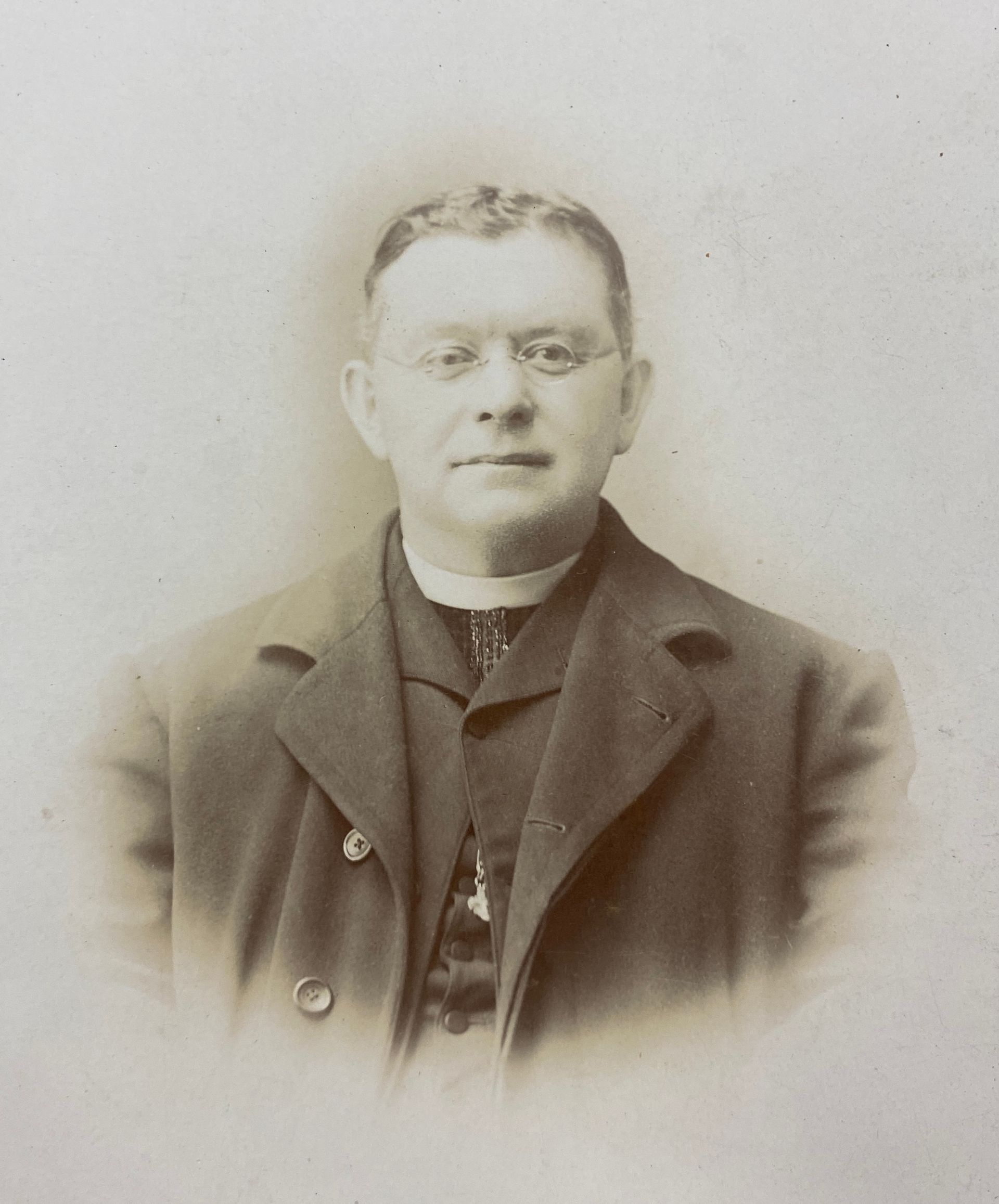
Rev. Casimir Renner, Pastor 1898-1907.
With great reluctance I submitted to the express wish of our Rt. Rev. Bishop to leave my good people at Menominee with whom I had become so familiar, and move to Randolph. Here I arrived on May 11th, 1898, and what did I find? A house – impractical as it could be for a priest to live in! A church 26x40! No, it was no church! Inside and outside it gave one the impression of a horse stable. Not one whole window could I find; lumps of plaster, spider webs of all dimensions hanging from the side walls and ceiling. seemed to be the decoration of the inside church. More than discouraged, I was inclined to leave the place at place at once. Only obedience to my superior prompted me to stay and try the best I could to build up.
The work of the pastor with his people proved very successful against all hope, both morally and temporally. First of all the little poor church must be repaired. For this purpose a collection was taken in June, 1898, and also the census, in order to ascertain how many Catholic families were living at Randolph and vicinity. By means of this collection $132 were realized and 75 families found. This amount of money was fully sufficient to repair the church, but there were a number of uncollected notes in favor of the church and so at a trustees meeting we came to the conclusion not only to repair the old church, but also to enlarge the same. In the beginning of September, 1898, we began building and in December the same year the church was finished at a cost of about $2000, of which the last $75 was paid to the Edwards & Bradford Lumber Co. in February, 1899.
Now we had a nice little church, but the interior of it had to be somewhat beautified to make it fairly fit for the service of the Most High. Not only did we enlarge the church, but also the grounds around the church, by purchasing ten more lots just north of the church, and to give the grounds a better appearance, a number of trees, rose-bushes and some ornamental shrubs were planted.
More necessary however, was it to erect and beautify the edifice of virtue of the inner man. For this reason the Catholics were given ample opportunity to accomplish that end. In order to strengthen the young in the practice of religion, our Rt. Rev. Richard Scannell visited Randolph for the first time on September 27, 1898, to administer the Holy Sacrament of Confirmation to a class of over one hundred young Catholics. On October 23rd of the same year a ten days Mission began and was very successfully conducted by the zealous missionary, Rev. M. Neumiller, S. J., who three years ago departed this life to receive his heavenly reward. Thereupon the Catholics realized more than ever that the house of God must be beautified as much as means would allow.
Therefore the first thing was to provide the yet barren church with a fine high altar. Then Mr. Jos. Wurdinger collected money for the stations of the Way of the Cross. Plenty of money was contributed and the fine stations were ordered. Meanwhile two chimed bells arrived and were blessed by Very Rev. Jos. Ruesing. The larger was named St. John, donated by Mr. John Gubbels; the second, donated by Mr. Peter Winkel, was named St. Peter and St. Anna. After this the stations arrived and faculties again having been granted to Very Rev. Jos. Ruesing, he erected the Way of the Cross on March 14th, 1899. Now to do a helping hand in the ornamental work, and at the same time to foster devotion to the Mother of Our Redeemer, Mr. and Mrs. Chris. Nepper kindly donated the beautiful and lovely statue of the Heavenly Queen. Also a new organ was donated by the choir of the congregation.
In the year 1901 a parcel of land was procured for the much needed and long talked of cemetery. For the small consideration of $50, Mr. Gerard Ashoff deeded to the congregation three acres of his land one mile north of the church, and nicely located on the hill for said purpose, for which we certainly must be very thankful to that gentleman. All this is very well and good, done for the greater honor of God; undoubtedly will rest the blessing on those who so nobly assisted in enlarging and beautifying our beloved church. But what would all these sacrifices avail if there is nothing provided for training our children in a Christian life? What is the use of building great magnificent churches, if our children can not enjoy a thorough Christian education? The great Bishop Ketteler said once: "Close your schools, do away with them, and you will soon be bound to close your churches also." Give us the youth, the freemasons say, and we have the future. Therefore the hatred and work against Catholic schools all over the world. Yes, if everything would come to an end at the close of life; if there was no eternity; if man did not consist of a body and immortal soul; if no account of life would be required at the end of it, then yes. Then we should make money as much as possible for the gratification of our senses. Then we could say with the heathens, "Let us eat and drink and enjoy life, for after death all is over." Considering these truths and many more, it must become apparent to any one that a Catholic congregation without a parochial school, is not completed, does but half work.
Some of our good Catholics, when the question arose, whether to build a school, did realize the importance and necessity of erecting a school, but a great many did not. They were indifferent regarding this proposition. Notwithstanding the latter fact the Rt. Rev. Bishop was asked permission for providing the congregation with a school, and subscription papers were laid up on St. Joseph's day, March 19th, 1899, and two Sundays in succession. The Rt. Rev. Bishop did grant permission most readily and joyfully; but the good people were very slow in subscribing. With some outside donations the sum of $1700 was finally reached. Who will not shrink from the idea of building a school with such an amount of money? Nevertheless, trusting in the help from above and placing the undertaking under the protection of St. Joseph, we commenced building in June 1899, and opened the school on September 14. 1899, with a fair number of children.
Our confidence in God's help has not been frustrated by any means. The subscription being not at all adequate to the circumstances of our people, though the school with contents, cost $4000. In February, 1901, the balance of the debt on the building ($700) was paid. So in spite of all opposition the Randolph congregation has a free parochial school and paid for.
The structure is not as one would say, built fashionably, but is comfortable for Sisters and children. Although some of our good people thought, and are yet of the opinion that a parochial school is a nuisance, it has been and is nevertheless a great blessing for St. Frances congregation of Randolph, would people only appreciate it.
Some years ago a move was on foot to enlarge the building, so that a little more room could be secured for the Sisters and a study course of twelve grades for children could be established. Mr. Henry Lorge was appointed to look for subscribers. The subscription ran as high as $900. It should be clear to any one concerned, that with this small sum an addition to cost $2000 or $3000 could not be constructed. The plan had to be abandoned and the blame had to be laid upon the pastor. Last year, however, a fourth school room was furnished and one more Sister obtained, so that our children can study some higher branches as given on another page in the program of the school. According to our circumstances, it must be acknowledged the school is in splendid condition. That we can not compete with other similar institutions is not for lack of good will, or able teachers and directors; it is the want of means, the shortcoming of funds and last but not least, the lack of interest on the part of our Randolph Catholics.
Now the school is running, thanks be to God, and our little ones enjoy very much to attend the Sisters' school. This, however, causes a great expense to the congregation: more money must be raised consequently; the congregation became larger, the members of the church are more numerous than in the year 1898. Therefore more seating capacity must be provided for in the church, that the income may be also increased. Considering these facts we find the church too small. From this the necessity arises to construct a new church, as some said of brick, or enlarge the old. But could the building of a new church be undertaken, or even considered, with a congregation which would not as much as raise a decent sum for the school building? Having had some experience to that effect, the idea of a new church had to be banished. After taking a vote whether to enlarge the church. the majority voted affirmative, and a few gave expression to their noble Christian feeling by saying, "The church is large enough for me, those who want a larger, let them build it.'
Not heeding such selfish talk the permission of the Rt. Rev. Bishop was obtained and the enlarging, more according to architecture, was accomplished in the year 1901, without any aid from the congregation except some pew rent. Certainly has the pastor entertained hope that the people, realizing the necessity of the undertaking, would lend a helping hand voluntarily, but he has been nicely deceived with his ideas. Although the pastor satisfied the workmen almost alone, the debts on the church had to be increased. This necessitated another collection. It was announced in church that the census and collection must be taken up which should bring at least $2000, very little indeed of 130 families for such a building. Here another deception was provided for the pastor; for instead of $2000, but $1400 was subscribed and of it $1100 paid up to this very day. So done in the year of our Lord, 1902.
The new enlargement of the church was completed and a fine spire was built. Then a bell of thirteen hundred pounds in weight was donated by Mr. Thomas Moser at a cost of $221. After this the people would like to have a pulpit in the new, larger church, 40x100 feet and Mr. Jos. Bichlmeier took up a collection and a beautiful pulpit and very handsome confessional were bought. Also credit must be given to Mrs. H. Lorge who donated the statue of the patron saint of the church, St. Frances de Chantal, imported from France. A church the size of ours should also be decorated with side altars. This the congregation felt well enough, therefore people made up their mind to provide side altars for the church, the men to buy St. Joseph's, the ladies the Blessed Virgin Mary altar. Soon the beautiful altars arrived and $260 paid for them. Now St. Joseph's altar was not complete without the statue of St. Joseph; so one of our good men, Mr. Jos. Wurdinger, heeding the inspiration, had $26 to spare and to please St. Joseph in Heaven his patron saint, placed his statue, beautiful as it is, upon his altar. The statue of St. Anthony, Sacred Heart of Jesus, and the very beautiful sanctuary windows, the pearls of the church, as once a priest called them, are the gifts of the then resident pastor. Not to forget the statue of the sorrowful mother Mary, which is another gift of Mrs. C. Nepper; the shrine for the statue was donated by the Christian Mothers Association of St. Frances congregation. For all this, the enlarging of the church and the beautifying of the same, the construction and equipping of the school and the improving of the priest's house have been expended up to this very time, 1907, about $17959.20. The cost of all, however, would run as high as $21559.20, therefore remains $3600 in debts to pay yet. To this the congregation contributed by collections, assessments, fair, etc., about $11202.87; the rest came from other sources, from donations, from Ludwig Mission Verein, from the pastor alone $3324. Still some debts remain shown, but if the collection now on foot will be somewhat fair, the debts will be done away with before another year passes into eternity. Read, my dear friend, the beginning of this little history carefully and compare the end; must you not acknowledge the great success, the immense work accomplished inside of nine years? To whom is this success due? First of all undoubtedly to the blessing of God; that God blessed this congregation no one can deny; secondly it is due to the faithful co-operation of the majority with their pastor.
Notwithstanding the great success that has been attained, there are a goodly number of kickers who can never be satisfied. Some went even so far as to give up all practice of their religion and place the cause of it upon the shoulders of their pastor, thinking and saying he is not the man for such a place as Randolph. Maybe you are right; I have thought so myself; therefore they tried their best to drive him out of the place. God will bless them for it. Would these people simply sit down and examine their own conscience a little sincerely they would soon find they are the most lukewarm and indifferent Catholics; that the blame rests with themselves.
We all know that the mother of the Christian family is, or should be, the guard and the guide of all moral virtues in the family, that through the agency of the mother the good character in the child must be formed and trained; that she must be the model of a faithful Christian life to her children, even to the father of the family. And in order to bring home to the knowledge of the mothers of this congregation more forcibly these far-reaching duties of their state of life, the widespread association of the Christian Mothers has been introduced by the pastor and canonically established by the Rt. Rev. Bishop Richard Scannell in 1899. On March 19, 1900, the feast of St. Joseph, the first members were received; Mrs. Catharina Nepper being elected first president and Mrs. Mary Hoffman secretary and treasurer. The membership since has grown to the number of 93. The meetings of the association are held the 4th Sunday of each month after high mass, where a special instruction is given by the reverend Director on the duties of a Catholic wife and mother. At present this branch of the association is in a flourishing condition. Also the Sodality of the Blessed Virgin Mary for young ladies has been canonically established on May 23, 1902 and affiliated at Rome July 5, 1902.
Regarding the moral standing of the St. Frances congregation we have testimonies of different priests, working here at the 40 hours devotion and other occasions, to the effect that St. Frances is one of the best congregations in the diocese of Omaha.
It could not be passed unmentioned, that the frequentation of the Sacraments is indeed praiseworthy; not less edifying is the devout attention of divine service on Sundays and days of obligation. All in all much credit must be given to the Catholics of Randolph, with a few exceptions, for the faithful practice of their religion. Great zeal in fulfilment of their Christian duties can be noticed especially with young folks.
These facts related in these few lines, regarding the temporal as well as the moral standing of this congregation show plainly that among the 122 families of which the congregation consists at present, there are many who, with their pastor, spared neither work nor sacrifice to build up the congregation; but there are a number of others who show no interest whatever towards their church and school, who gave expression of their black ingratitude by criticizing everything and causing all kinds of trouble to others and especially to their priest. May God forgive them and may the successor of the present pastor find no faults with his people but be able to continue this history of the Randolph Catholic Congregation more favorably. May God bless this congregation also in the future as He did in the past. – C. R.
(C. Renner, Pastor, A Brief History and Financial Statement of St. Jane Frances de Chantal Church, Randolph, Nebraska 1907)
Quick Links
Contact us
Office: 402-254-6559
Fax: 402-254-6553
email: holytrinity@hartel.net
406 South Broadway, PO Box 278
Hartington, NE 68739
